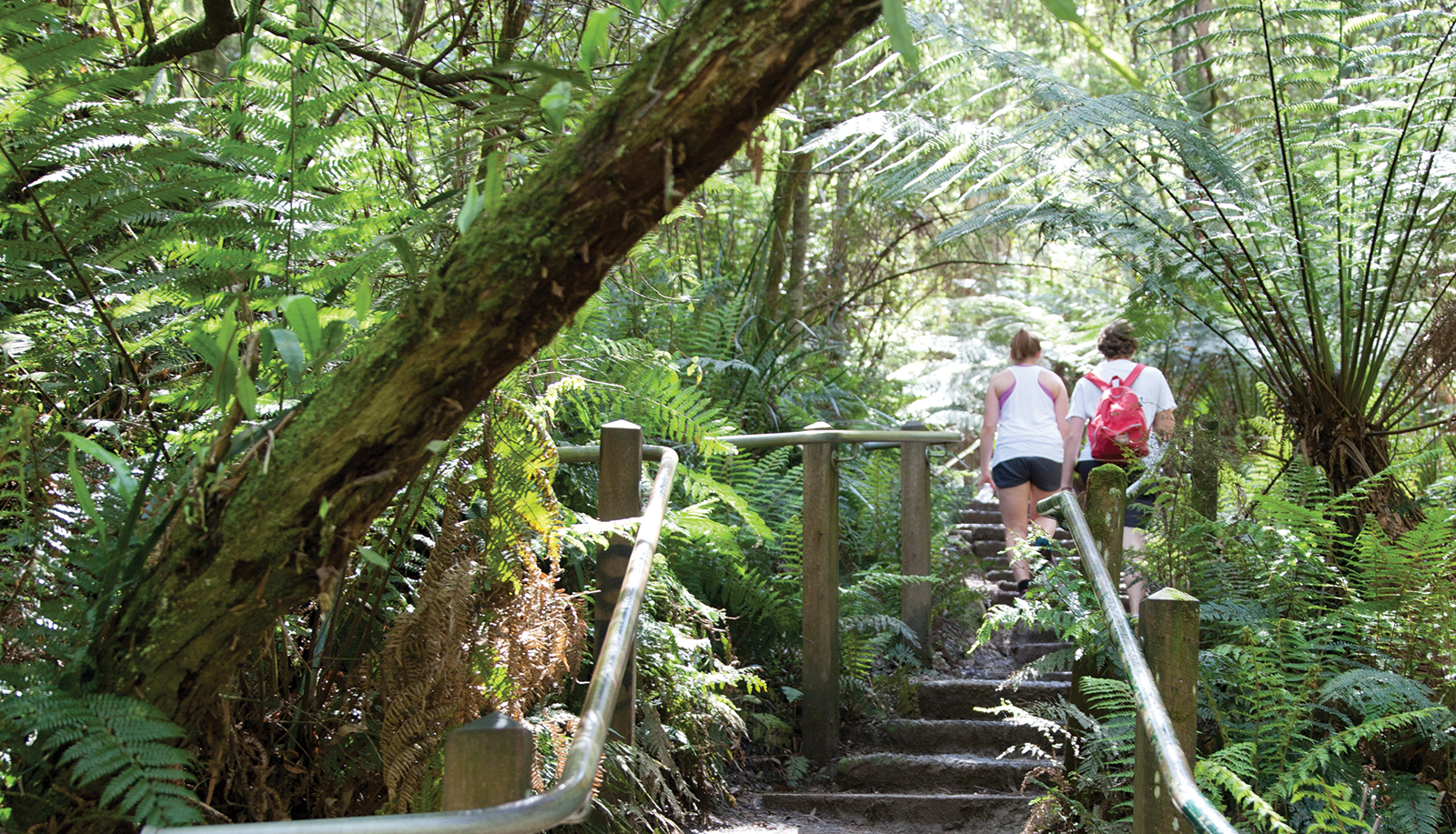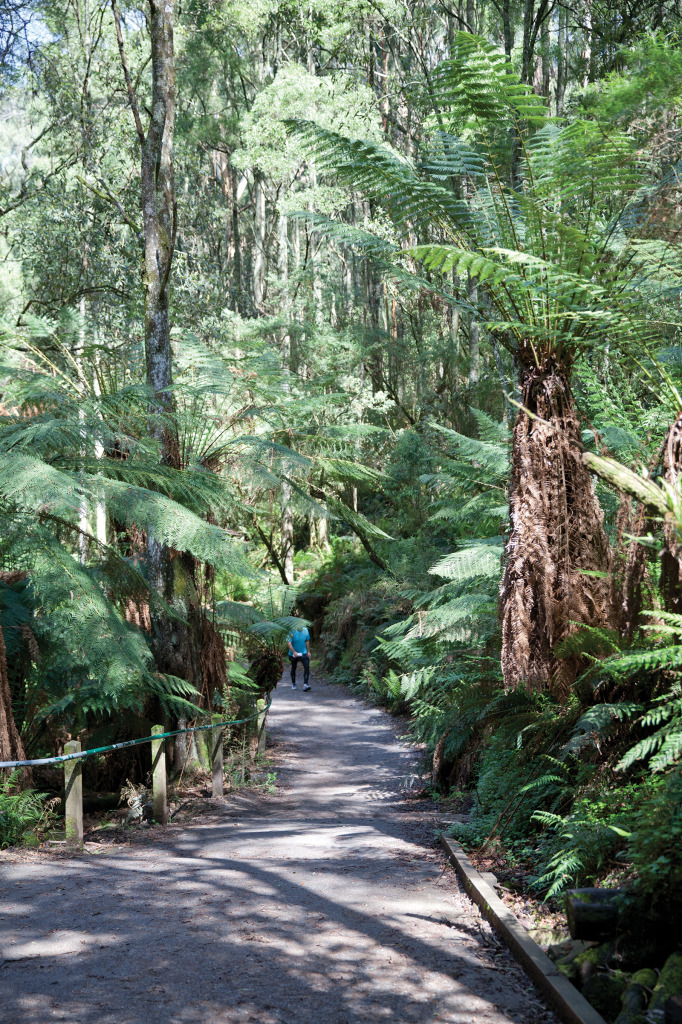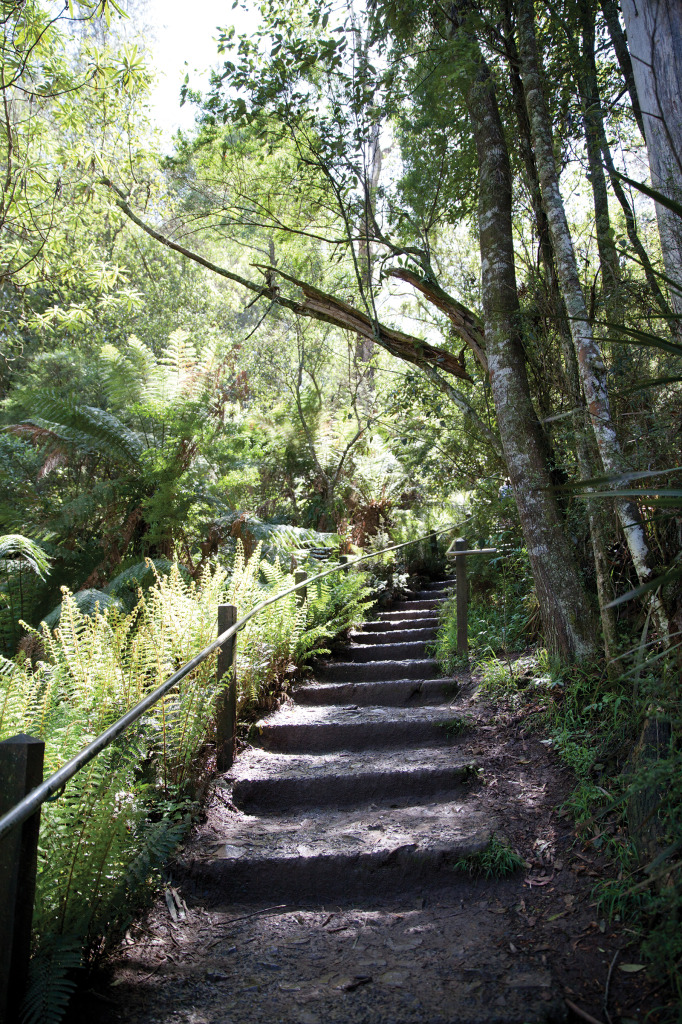Alys Francis donned her sneakers and a fair amount of grit to run the famed 1000 steps in Upper FernTree Gully.
It’s dawn in mid-winter and, while most people are still pouring out their cornflakes, I’m standing in a sprawling, tree-lined car park staring up at Mount Dandenong looming above.
Like countless thousands of people before me, I’ve set my alarm for an ungodly hour, rolled out of bed, laced up my sneakers and come to this park in Upper Ferntree Gully for one reason: to run the famed 1000 Steps track, a heart-thumping 275-metre ascent to One Tree Hill Picnic Ground.
There’s only a handful of cars about, the sun has not yet broken the ridgeline of Upwey and the forest before me is dark with shadow. This is my first time on the 1000 Steps, also known as the Kokoda Memorial Trail.
I have no idea what lies ahead but I’ve heard the stories – this track has a reputation, a reputation that has lead to the creation of a Facebook page, and means that when you type ‘1000’ into Google, the auto-complete function fills in the word ‘Steps’ – that’s right, this little track an hour east of Melbourne is famous, according to Google.
Hordes of people make the pilgrimage here every weekend to take on the mountain, through rain, hail, pea soup Ranges’ mist, or shine; soy latte-sipping Melbournians, fitness fanatics, senior citizens, AFL teams, locals and tourists – roughly 70,000 every month, according to Parks Victoria.
And now I’ve come here too, not just to see if my tendons are up to it but to find out what all the fuss is about; how has this little 1.5km track, like so many other forest trails twisting through Mount Dandenong like veins, become one of the most popular runs in Australia? I do a few cursory stretches, trying to steel my mind. The Rocky anthem begins thrumming in the back of my throat. Ok, no more stalling, I take off.
The 1000 Steps has a long history. First dug into the mountain following a creek along a gully in the early 1900s, they were originally made from the trunks of tree ferns before the concrete steps were installed in 1950.
In 1998, the park was adopted by Kokoda veterans who thought the steps were similar to the first 100-metres of the Papua New Guinea track in World War II.
In 2011 the state government announced a $1.5 million redevelopment for the park, including new picnic shelters and a memorial wall and terrace for public ANZAC and Australia Day services. But while these changes were taking place, the track’s popularity among runners had been steadily growing. In the early 2000s, 50-60,000 people were visiting the park. By the time the redevelopment was announced, visitor numbers had skyrocketed to around 500,000 per year, according to Parks Victoria.
Concerns about veterans being elbowed aside by the sweaty weekend pilgrims prompted the government to include a fitness track as part of its upgrade. The Lyrebird Track Fitness Steps were specially designed by a sports scientist to lure the fitness fanatics with the promise of reduced joint fatigue and distance markers to track their speed. Since the redevelopment was first announced, Parks Victoria says the number of visitors has further increased by 300,000 to 800,000 per year. With the final stages of work finished last April, it surely won’t be long before the park hits the 1 million mark.
The lure of the steps is so strong that even on total fire ban days last summer, when the park was closed for safety reasons, runners were seen parking on the road and making their way into the forest on foot.
But why? Why risk being caught in a bushfire to run up a mountain? The first few hundred metres past the memorial wall to the park entrance jolts my heart from its early morning slumber.
I reassure myself by thinking about the fact that past runners have counted only between 770 and 776 steps.
As I jog along, the track grows thinner, steeper and rockier. The forest, thick with tree ferns, manna gums and scrubby grasses, seems to close in and I find myself surrounded by birdcalls.
I eventually reach a small clearing where I see the first signs of other runners: a railing, strewn with discarded jumpers and hoodies, below which lie numerous water bottles and coloured sports drinks.
This is where things get serious. At a break in the railing the steps begin rising up the mountain, small, uneven, worn and muddy. Barely a metre away signs warn people not to run or dump jackets as they are “regularly” cleared away.
Not wanting to be the first to follow the rules, I hit the steps jogging but I’m soon forced to include shuffling and awkward leaps due to huge puddles covering the short stretches of track between sections.
The steps are slippery and some have raised edges where the concrete has sunk down, perfect for tripping fatigued toes.
Just as I’m thinking about the liability risk, I hear a jogger pounding down ahead. I look up and see a woman in her 50s flash by in a blur of stretching Lycra. I suddenly feel like I need to lift my game.
As the steps grow wider and steeper the birdcalls are slowly drowned out by my panting. It can’t be too much further surely? But the steps keep getting steeper, so steep that I’m soon grasping the railing and dragging myself up like a mountaineer. I feel like an idiot until I see a girl ahead doing the same.
Then all of sudden I’m at the top.
I turn around to go down and see the steps unfurling down the hill, rocks protruding from their sloping concrete surface like shark teeth. After a few sections, my fear of slipping eases and gives way to mental images of myself starring in an ad for some kind of sports deodorant – I’m really having fun.
The jumpers and water bottles are still there when I reach the bottom, making me wonder briefly if their owners fell victim to the shark-like steps. Then it’s just a quick sprint and I’m back at the Kokoda Memorial terrace. Four pillars, the Kokoda values carved into their sides, tower above me: Endurance, Courage, Mateship, Sacrifice.
With the sweat still cooling on my forehead, I suddenly feel humbled, and I’m surprised. As I look at the statues of soldiers, I can’t help but think of the men they represent and how those that returned to Australia chose this hillside in the Dandenongs as their memorial.
I did not expect to be so moved by this place. I jog back to the car park, already thinking about when next I can return.




